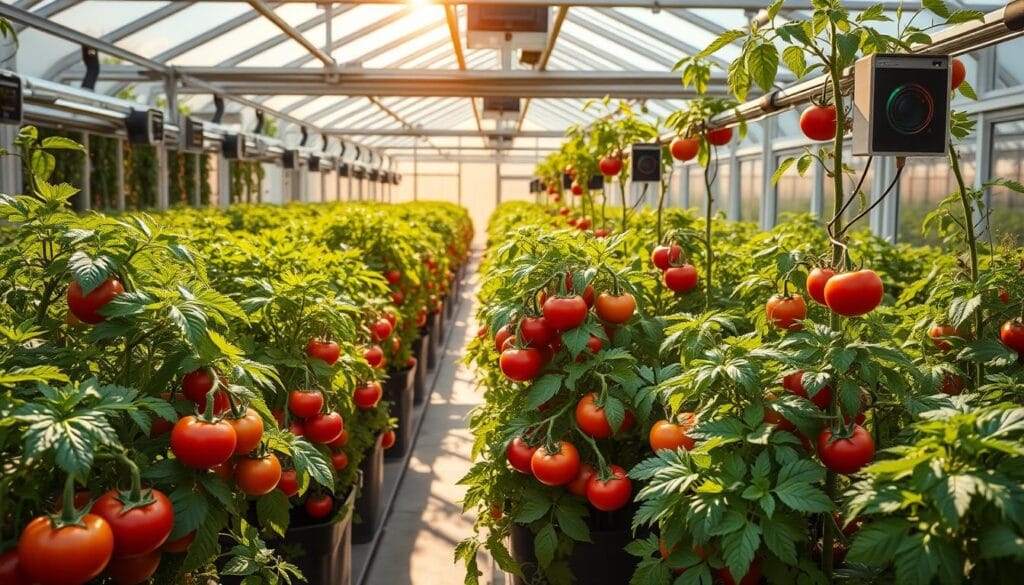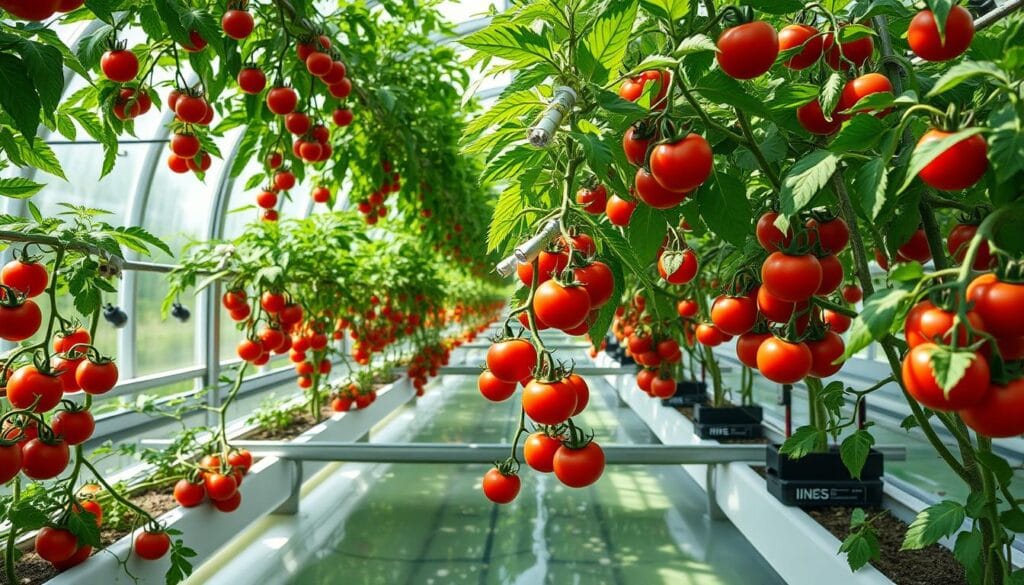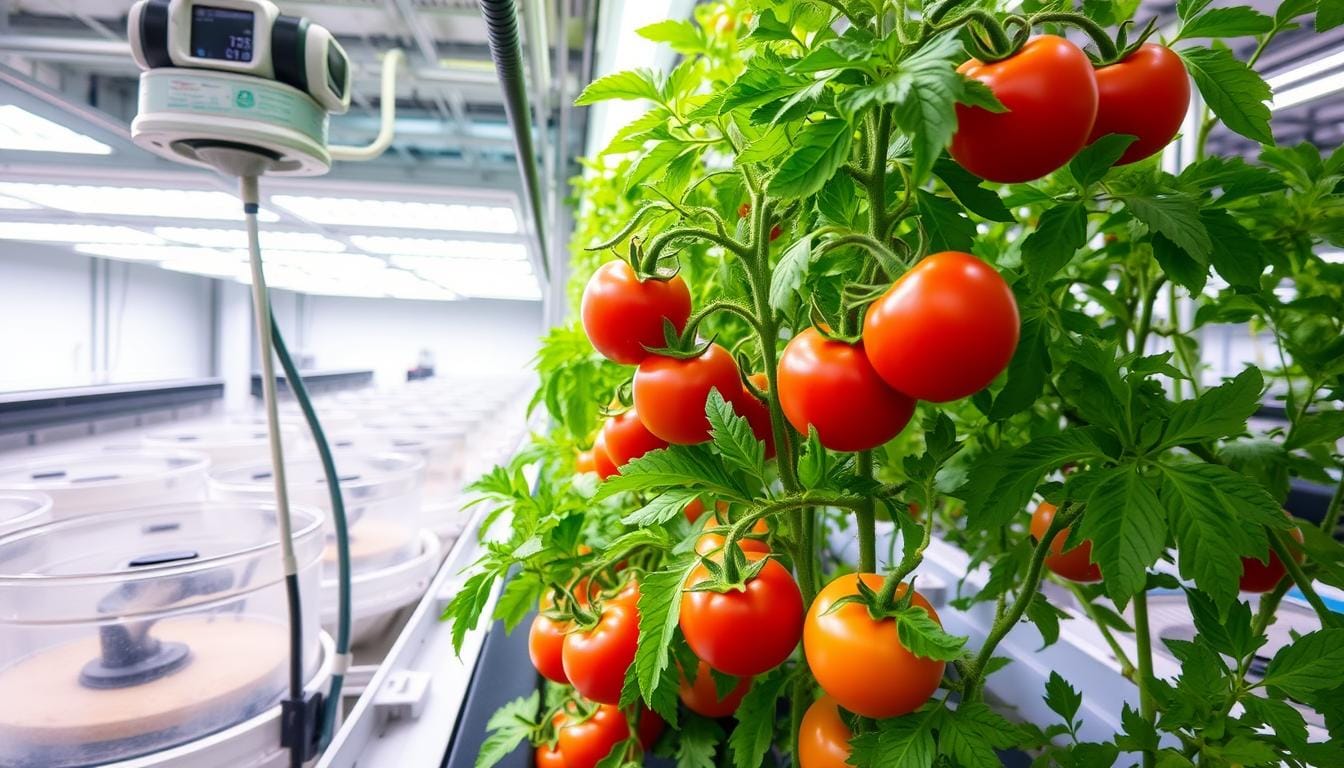Temperature and humidity management for hydroponic beefsteak tomatoes is crucial. Exploring hydroponic tomato growing shows how vital temperature and humidity control is. These factors greatly affect your plants’ health and output. Keeping the climate right in hydroponics is key to high yields and top-quality tomatoes.
Knowing how to manage temperature and humidity is essential for your plants’ flourishing. By learning about hydroponic tomato growing, you’ll enjoy a rich harvest of tasty and healthy beefsteak tomatoes. To do this well, you need to understand how these factors influence plant growth.
Key Takeaways
- Temperature and humidity management is critical for hydroponic beefsteak tomato growth
- Precise climate control is essential for maximizing yields and quality
- Hydroponic tomato cultivation requires a deep understanding of temperature and humidity relationships
- Effective management of temperature and humidity leads to healthier and more productive plants
- Optimizing temperature and humidity conditions is key to a successful hydroponic beefsteak tomato harvest
Understanding the Basics of Hydroponic Tomato Climate Control
To grow tomatoes well in hydroponics, knowing about temperature and humidity is key. Keeping these factors in check helps plants grow strong. Tomatoes need the right temperature at each growth stage.
Temperature is vital for tomatoes as it affects how they breathe and grow. Keep the day temperature between 65-70°F (18-21°C) and the night around 55-60°F (13-15°C). Humidity should be between 40-60% in your system.
The Role of Temperature in Tomato Development
Temperature is critical for tomato growth. It’s important to keep it just right for healthy growth. You can use heaters, coolers, insulation, and shade to control it.
How Humidity Affects Plant Growth
Humidity greatly impacts plant health. It’s important to keep it at the right level in your hydroponic system. Utilize humidifiers or dehumidifiers to regulate humidity levels as necessary.
The Relationship Between Temperature and Humidity
Temperature and humidity work together to help plants grow. By managing both, you can create the best conditions for tomatoes. This leads to better growth and more fruit.
Some important things to think about include:
- Keeping the right temperature for each growth stage
- Managing humidity for healthy growth
- Using heaters, coolers, insulation, and shade for temperature control
- Using humidifiers or dehumidifiers for humidity control
Knowing how to control climate in hydroponics helps your tomatoes thrive. Always check temperature and humidity and adjust as needed. This helps ensure your plants thrive and yield abundantly.
Optimal Temperature Ranges for Different Growth Stages
For beefsteak tomato production, knowing the best temperatures at each stage is key. In indoor tomato farming, keeping the right temperature is hard but vital for healthy plants and high yields.
Seedlings need a warm spot, between 65-70°F (18-21°C). As they grow, the daytime temperature can go up to 70-75°F (21-24°C). At night, it should drop to 65-70°F (18-21°C). This change helps plants grow well and produce fruit.
Some important temperature tips for beefsteak tomato production are:
- Average temperature: 70-75°F (21-24°C)
- Nighttime temperature: 65-70°F (18-21°C)
- Soil temperature: 65-70°F (18-21°C)
In indoor tomato farming, watching the temperature closely is critical. The right temperatures help plants grow, avoid diseases, and boost yields.
By sticking to these temperature guidelines, you can improve your beefsteak tomato production and get a big harvest. Always check the specific temperature needs for your indoor tomato farming setup for the best results.
Essential Humidity Levels for Beefsteak Tomatoes
For growing beefsteak tomatoes in hydroponics, keeping humidity right is key. In a greenhouse, you can adjust humidity to make a perfect spot for your plants. Keep it at 60-70% during the day to help them grow well and stay healthy.
At night, let the humidity go up to 70-80%. This helps your plants recover from the day’s stress. But, don’t let humidity get too high. Too much can cause diseases and damage the roots. By managing humidity, you help your tomatoes grow strong and healthy.
Daytime Humidity Requirements
During the day, plants need a bit of moisture to breathe and grow. A humidity of 60-70% is perfect for this. Use a humidistat to keep an eye on and adjust the humidity in your setup.
Nighttime Humidity Management
At night, plants need a bit more moisture to heal and get ready for the next day. A humidity of 70-80% is best for this. It helps them breathe easier and grow stronger. By managing humidity, you create a healthy environment for your tomatoes.
Seasonal Humidity Adjustments
Humidity needs to change with the seasons for your tomatoes. In summer, lower humidity helps avoid too much moisture and diseases. In winter, higher humidity helps them grow in the dry air. Adjusting humidity with the seasons helps your plants thrive.
| Season | Humidity Level |
|---|---|
| Summer | 50-60% |
| Winter | 70-80% |
| Spring | 60-70% |
| Autumn | 60-70% |
Temperature and Humidity Management for Hydroponic Beefsteak Tomatoes
Exploring hydroponic beefsteak tomatoes? It’s key to grasp the role of temperature and humidity management. These elements are critical for your crop’s quality and yield. With the right temperature and humidity management tactics, you can foster a perfect environment for your plants.
In tomato growing techniques, temperature and humidity are essential. Hydroponic beefsteak tomatoes prefer a temperature between 65-75°F (18-24°C). The ideal humidity is 50-60%. Keeping these levels ensures your plants grow well and stay disease-free.
Effective temperature and humidity management includes:
- Regularly check temperature and humidity levels
- Adjust the environment to fit your plants’ needs
- Utilize climate control systems for optimal conditions
By adhering to these tips and using smart temperature and humidity management strategies, you can boost your hydroponic beefsteak tomatoes’ yield and quality. Keep up with new tomato-growing techniques and tweak your methods for the best outcomes.
Setting Up Your Climate Control System
Controlling temperature and humidity in hydroponics is key for plant growth. In hydroponic vegetable cultivation, the right temperature and humidity are vital. They greatly affect the quality and yield of your crops.
To start, you need to pick the right equipment for your climate control system. This includes temperature and humidity sensors, and heating and cooling systems. Think about the size of your grow space and your plants’ needs when choosing.
Choosing the Right Equipment
- Temperature sensors: Place these throughout your grow space for accurate temperature readings.
- Humidity sensors: They help monitor and control humidity levels in your space.
- Heating and cooling systems: You might need heaters, air conditioners, or evaporative coolers, depending on your needs.
After picking up your equipment, it’s time to install and calibrate your system. Connect your sensors and systems. Then, set up your controls to keep the best temperature and humidity for your plants.
Monitoring Tools and Technologies
Exploring greenhouse climate control and indoor tomato farming means keeping up with new tools and tech. These advancements help you keep the climate just right for your tomatoes to grow well.
Some important tools and technologies include:
- Temperature sensors
- Humidity gauges
- CO2 monitors
- Light spectrum analyzers
Using these tools lets you control the environment for your tomatoes. Whether you have a big greenhouse climate control setup or a small indoor tomato farming space, these tools help you make smart choices for your crop’s growth.

In the world of indoor tomato farming and greenhouse climate control, staying updated is key. By using the latest monitoring tools and technologies, you’ll grow healthy, thriving beefsteak tomatoes.
| Monitoring Tool | Application |
|---|---|
| Temperature sensors | Tracking temperature fluctuations |
| Humidity gauges | Monitoring humidity levels |
| CO2 monitors | Regulating CO2 levels |
Common Climate Control Challenges
Managing temperature and humidity for hydroponic beefsteak tomatoes can be tricky. You might see sudden changes in temperature or humidity. These changes can affect your tomatoes’ health and growth.
Understanding why these changes happen is key. For example, a cold drop can slow down your plants. High humidity can cause diseases. By keeping an eye on your system and adjusting it, you can keep your tomatoes healthy.
Dealing with Temperature Fluctuations
Temperature changes can come from many sources. This includes broken equipment, power outages, or weather shifts. To handle these, you can use backup systems like generators or batteries. You can also use insulation and thermal mass to keep temperatures steady.
Managing Humidity Spikes
High humidity can be caused by hot weather, bad ventilation, or too much water. To control it, you can use dehumidifiers, improve airflow, or use less water. It’s important to check humidity levels often and adjust as needed for your tomatoes.
By tackling common climate control issues, you can grow healthy tomatoes. Always watch your system and tweak it to keep the right temperature and humidity for your tomatoes.
| Challenge | Cause | Solution |
|---|---|---|
| Temperature Fluctuations | Equipment failure, power outages, changes in outdoor weather conditions | Backup systems, insulation, thermal mass |
| Humidity Spikes | High temperatures, poor ventilation, excessive water usage | Dehumidifiers, improved ventilation, reduced water usage |
Disease Prevention Through Climate Management
Creating the best conditions for tomato growth is key. This means controlling temperature and humidity in hydroponics. The right climate can stop diseases from harming your crop. Studies show that specific temperatures and humidity levels can either help or hinder disease growth.
Fungal diseases love humid places, while bacterial diseases prefer warm, wet spots. By managing these factors, you can make your hydroponic setup less friendly to diseases. Keeping the temperature and humidity just right is vital for your plants’ health.
Here are some ways to prevent diseases through climate control:
- Keep temperatures between 65-75°F (18-24°C) during the day and 55-65°F (13-18°C) at night.
- Control humidity to avoid moisture buildup, which fungi hate.
- Ensure good airflow to stop diseases from spreading.
Using these methods can help your tomatoes grow well and stay disease-free. This approach also cuts down on the need for harmful chemicals. It makes your hydroponic system greener and more sustainable.
Remember, managing temperature and humidity is essential for healthy plants. By keeping the climate right, you create a perfect spot for tomatoes to thrive. This also lowers disease risks.
| Disease | Optimal Temperature Range | Optimal Humidity Level |
|---|---|---|
| Fungal diseases | 65-75°F (18-24°C) | 40-60% |
| Bacterial diseases | 55-65°F (13-18°C) | 30-50% |
Energy-Efficient Climate Control Methods
Looking into ways to improve your hydroponic vegetable growing? It’s key to focus on energy-saving climate control. Greenhouse systems can be made to use less energy while keeping plants happy. Smart tech helps you adjust temperature, humidity, and light for the best growing conditions.
There are smart ways to save energy in climate control. Here are a few:
- LED grow lights use less power than old lighting
- Use natural airflow and shade in your system
- Insulation and double-glazed windows cut down on heat loss
Using these methods can make your hydroponic system greener. Smart tech lets you control your greenhouse from afar. This keeps your plants in the perfect environment.

To save money, think about a climate control system that changes settings based on time and season. This cuts down energy use and lowers bills. Also, using rainwater and composting makes your system more eco-friendly.
Troubleshooting Temperature and Humidity Issues
Even with top-notch systems, temperature and humidity problems can happen in hydroponic beefsteak tomatoes. It’s key to spot and fix these issues to keep your crops healthy. First, check your climate control system for any problems or wrong settings.
Look out for temperature changes and humidity spikes. These can stem from broken equipment, wrong settings, or seasonal shifts. Knowing why these problems occur helps you avoid them and keep your tomatoes growing well.
To solve temperature and humidity problems, try these steps:
- Inspect your equipment for any indications of damage or wear
- Verify that your climate control system is properly calibrated
- Monitor temperature and humidity levels regularly to identify any fluctuations
- Modify your system as required to ensure optimal conditions are maintained
By following these steps and keeping an eye on temperature and humidity, you can avoid common issues. This ensures your tomatoes keep growing well. Always focus on the best conditions for your tomatoes to get the best results.
Advanced Climate Optimization Techniques
Exploring hydroponic tomato cultivation reveals the importance of controlling temperature and humidity. Advanced techniques can elevate your crop quality and yields. These methods refine your hydroponic tomato cultivation, leading to better results.
Understanding hydroponic tomato cultivation allows you to tailor strategies for your plants. This includes managing Vapor Pressure Deficit (VPD), adding CO2 for growth, and creating microclimates for beefsteak tomatoes.
VPD Management and CO2 Integration
VPD management balances temperature and humidity for healthy growth. CO2 integration boosts growth and yields. Adding CO2 to your system creates an ideal environment for your tomatoes.
Microclimate Creation
Microclimates are advanced environments for your plants. They simulate ideal conditions for beefsteak tomatoes. Key factors include temperature, humidity, lighting, and CO2 levels.
- Temperature fluctuations
- Humidity levels
- Lighting conditions
- CO2 concentrations
Using these techniques, you can improve your hydroponic tomato cultivation. Expect higher yields, better quality, and a more efficient process.
| Technique | Description | Benefits |
|---|---|---|
| VPD Management | Maintaining a balance between temperature and humidity levels | Healthy plant growth, increased yields |
| CO2 Integration | Incorporating CO2 into the hydroponic system | Enhanced growth rates, increased yields |
| Microclimate Creation | Designing a specific environment for the plants | Exceptional crop quality, increased yields |
Conclusion: Mastering Climate Control for Maximum Yield
Mastering temperature and humidity is key for top yields in hydroponic beefsteak tomatoes. This guide has shown you how to create the best growing space. It supports your crops’ growth and quality.
For success, take a complete approach to managing temperature and humidity. Keep the right temperatures and humidity levels at each stage. Use the latest tech to adjust your space for the best results.
Remember these climate control tips as you grow. By controlling temperature and humidity, you’ll get the most from your tomatoes. Follow these best practices and watch your tomatoes grow amazingly well.

